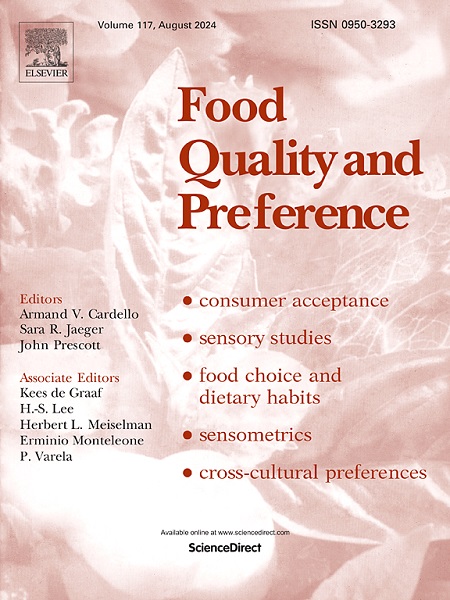The nature and origins of crossmodal associations to astringent solutions and basic tastes
IF 4.9
1区 农林科学
Q1 FOOD SCIENCE & TECHNOLOGY
引用次数: 0
Abstract
People match gustatory (basic tastes) and non-gustatory stimuli (e.g., colors, shapes, and textures) to each other in a reliable manner. Yet, whether other attributes of the experience of flavor, such as, for example, astringency also evidence such reliable crossmodal mappings is currently unknown. Therefore, the aim of this study was to assess whether individuals make reliable crossmodal mappings between astringent solutions and non-gustatory stimuli (e.g., colors, shapes, hand-felt roughness/smoothness), and to examine the basis of any mappings observed. Participants sampled 6 solutions – astringent and 5 basic tastants – at 2 concentrations each (low, high), and for each selected their best matching color, texture, and shape (in three separate counterbalanced blocks). After making their selections, the participants evaluated the valence of the solutions, their colors, textures, and shapes, as well as the qualities/intensities of the solutions, and their confidence in the matches they made. Participants reported the rationale for their color-, texture- and shape matches at the end of the study. Color, texture, and shape selections evidenced consensual mappings, and participants were generally confident in all matches to a comparable level. Whilst people typically reported that their color matches were driven by real world associations (e.g., yellow chosen for sour, as lemons are yellow and sour), followed by valence (liking; e.g., pink for sweet, as both are liked), texture and shape matches to solutions were more attributable to intensity (e.g., rougher textures, selected for rougher feeling [e.g., astringent] solutions) as well as valence. Implications for flavor binding and marketing are discussed.
涩味溶液和基本口味的跨模式关联的性质和起源
人们以一种可靠的方式将味觉(基本口味)和非味觉刺激(如颜色、形状和纹理)相互匹配。然而,风味体验的其他属性,例如,涩味是否也证明了这种可靠的跨模态映射,目前尚不清楚。因此,本研究的目的是评估个体是否在涩味溶液和非味觉刺激(如颜色、形状、手摸的粗糙度/平滑度)之间建立可靠的跨模态映射,并检查观察到的任何映射的基础。参与者分别以两种浓度(低、高)取样6种溶液——收敛剂和5种基本品尝剂,并为每种溶液选择最匹配的颜色、质地和形状(在三个独立的平衡块中)。在做出选择后,参与者评估了溶液的价、颜色、质地和形状,以及溶液的质量/强度,以及他们对自己所做匹配的信心。在研究结束时,参与者报告了他们的颜色、质地和形状匹配的基本原理。颜色、纹理和形状的选择证明了双方同意的映射,参与者通常对所有匹配都有相当程度的信心。虽然人们通常报告说,他们的颜色匹配是由现实世界的联想驱动的(例如,选择黄色代表酸,因为柠檬是黄色和酸的),其次是价(喜欢;例如,粉色代表甜,因为两者都喜欢),质地和形状与溶液的匹配更多地归因于强度(例如,粗糙的质地,选择粗糙的感觉[例如,涩味]溶液)以及价。讨论了风味结合和营销的意义。
本文章由计算机程序翻译,如有差异,请以英文原文为准。
求助全文
约1分钟内获得全文
求助全文
来源期刊

Food Quality and Preference
工程技术-食品科技
CiteScore
10.40
自引率
15.10%
发文量
263
审稿时长
38 days
期刊介绍:
Food Quality and Preference is a journal devoted to sensory, consumer and behavioural research in food and non-food products. It publishes original research, critical reviews, and short communications in sensory and consumer science, and sensometrics. In addition, the journal publishes special invited issues on important timely topics and from relevant conferences. These are aimed at bridging the gap between research and application, bringing together authors and readers in consumer and market research, sensory science, sensometrics and sensory evaluation, nutrition and food choice, as well as food research, product development and sensory quality assurance. Submissions to Food Quality and Preference are limited to papers that include some form of human measurement; papers that are limited to physical/chemical measures or the routine application of sensory, consumer or econometric analysis will not be considered unless they specifically make a novel scientific contribution in line with the journal''s coverage as outlined below.
 求助内容:
求助内容: 应助结果提醒方式:
应助结果提醒方式:


